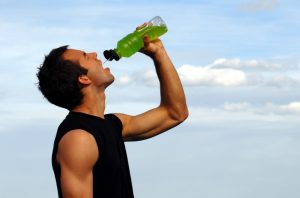Your post run, bike or swim recovery habit is the first and most important nutrition habit to establish! After a typical hour run you have drained about 100-175 grams of carbohydrate from your muscle tissue, crushed red blood cells from the force of impact, torn muscle fibers and connective tissues, caused inflammation, lost key minerals from sweating and started a chain reaction of unstable atoms called free radicals (because you are breathing in 20 times more oxygen than the normal sedentary person.* Whew! That’s a lot to get recovered from.
recovery habit is the first and most important nutrition habit to establish! After a typical hour run you have drained about 100-175 grams of carbohydrate from your muscle tissue, crushed red blood cells from the force of impact, torn muscle fibers and connective tissues, caused inflammation, lost key minerals from sweating and started a chain reaction of unstable atoms called free radicals (because you are breathing in 20 times more oxygen than the normal sedentary person.* Whew! That’s a lot to get recovered from.
The two most important macronutrients at this point are carbohydrate and protein. The carbohydrate will help resupply the muscle tissue with fuel, while the protein will help repair the torn tissues and blood cells. There are also a whole spectrum of antioxidant vitamins that have got to be replaced to fight of excessive oxidation and electrolyte minerals to replace what has been lost in sweat. So, how are you going to get all these needs met? There are two easy stages of recovery eating to understand and do.
STAGE 1
This stage only lasts about 30 minutes. It is when your muscle tissues are wide open and ready to receive a lot of carbohydrate. In order to reach the muscle tissue as quickly as possible it is best eat your carbs as a drink at this point. You will also need protein (at a ratio of 1/3 or ¼ of the amount of carbs), and vitamins and minerals so some drinks work much better than others at getting the job done. The first goal with the drink is to take in half of your bodyweight in grams of carbohydrate. So if you are 150 pounds, then you need 75 grams of carbs at that point. Read those labels! Drink as much as you need. Purchasing a drink like Ultragen, Recoverite or Endurox is the easiest and best option at this point. Making a homemade recovery shake works well too. Or, you can use 16-20 oz of real juices, 32 oz bottle of Gatorade or a higher grade drink mix like Cytomax. However, all of these 3 choices will require some protein added and more vitamins and/or minerals.
STAGE 2
This stage lasts about as long as the workout was. So an hour workout has an hour-long stage 2. The point of this part of the recovery process is to eat real, whole food. You need protein, carbs and fats. Lots of lean protein and produce at this time is a great idea. You will need to eat ANOTHER serving of half your bodyweight in carbohydrate and even more after long workouts. That will be a bit easier if you eat, not only fruit, dense veges or potatoes, but whole grains as well. Well, I guess the grain depends on if you can tolerate them okay. So a big hearty meal, no matter what time of day is best during this stage of recovery.
Just remember that while it might be a little difficult to eat after some workouts, it is very necessary to plan ahead, have what you need on hand and eat it. Even if you don’t feel like eating, you still need to eat. Actually, not feeling up to eating can be a symptom that your body is under too much stress. But, if you just commit to the habit of feeding yourself during your body’s greatest time of need to recover, refuel and repair, you will feel much better the next day and in the long run.
*Although oxygen is necessary for survival, breathing in oxygen also produces ‘oxidative stress’ in our bodies which leads to the to formation of free radicals and lipid peroxidation. Sadly, exercise just makes this worse since you are breathing in more air. These free radicals are atoms or groups of atoms that are short one electron. Being short one electron causes the atom to be unstable, so it seeks out and steals another electron from another atom, usually oxygen. This then causes a chain reaction as the victim of the stealing then needs to be stabilized and steals from yet another atom. The problem here is that once an atom has lost the original electron, the new one gained does not provide as strong or stable of an atom as the original. The problem that free radicals cause is system wide. They can attack the walls of your muscle cells and mitochondria and are at least partially to blame for muscle inflammation and soreness, which contributes to reduced endurance.24 Internal oxidation is also a cause of other serious problems including cancers, diseases and heart problems.25
24 Burke Edmund Phd Optimal Muscle Recovery Garden City Park, NY Avery Publishing 1999 Pg 40
25 Colgan ,M Phd The New Nutrition Vancouver BC apple publishing company LTD 1995 CH 20
